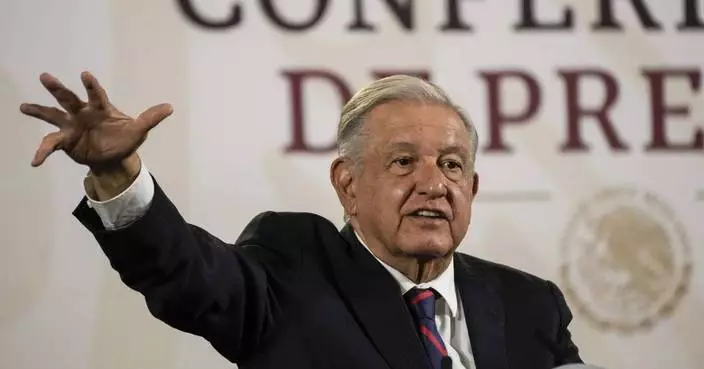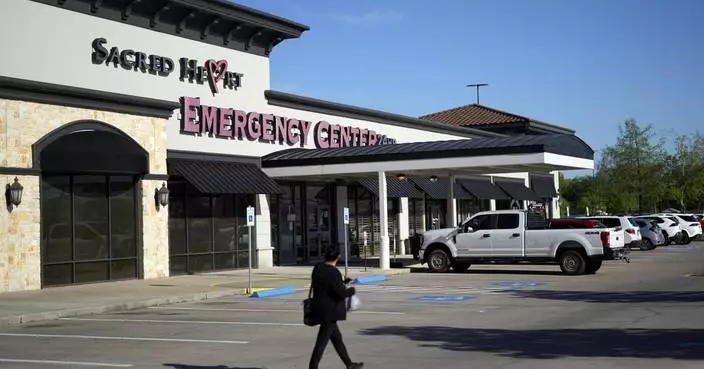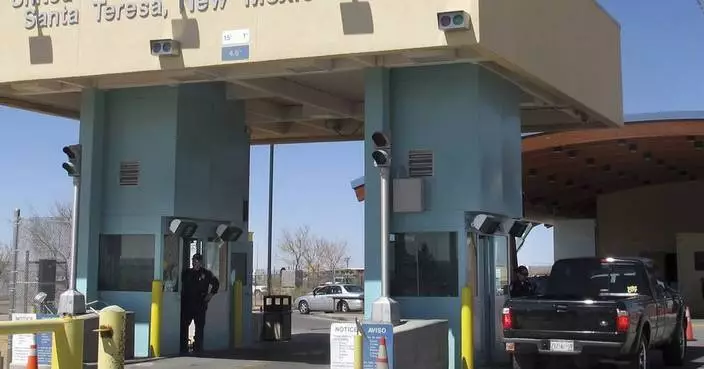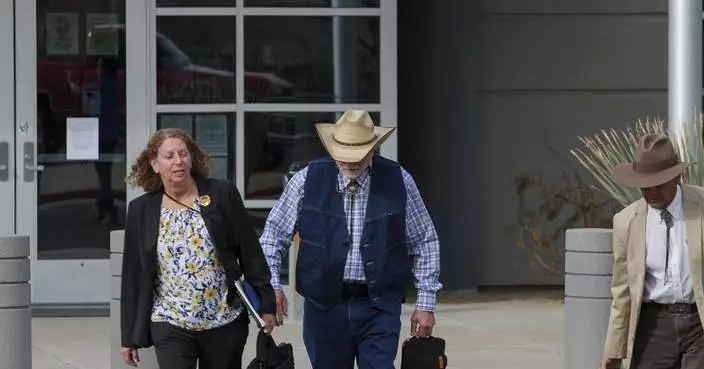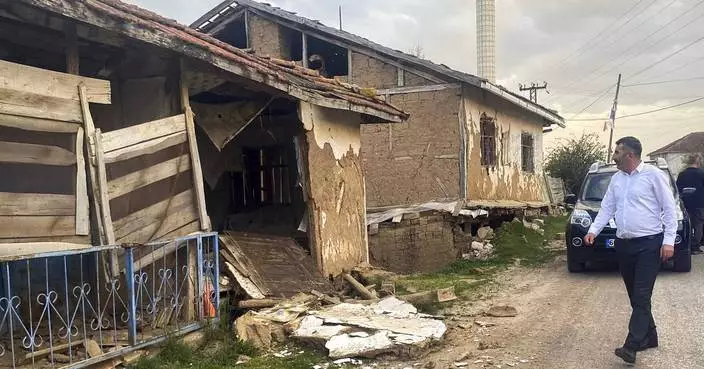A magnitude 7.1 earthquake stunned central Mexico on Tuesday, killing at least 139 people as buildings collapsed in plumes of dust. Thousands fled into the streets in panic, and many stayed to help rescue those trapped.

A construction worker searches a building that collapsed after an earthquake, in the Roma neighborhood of Mexico City, Tuesday, Sept. 19, 2017.(AP Photo/Eduardo Verdugo)
Dozens of buildings tumbled into mounds of rubble or were severely damaged in densely populated parts of Mexico City and nearby states. Mayor Miguel Angel Mancera said buildings fell at 44 places in the capital alone as high-rises across the city swayed sickeningly.
Click to Gallery
A magnitude 7.1 earthquake stunned central Mexico on Tuesday, killing at least 139 people as buildings collapsed in plumes of dust. Thousands fled into the streets in panic, and many stayed to help rescue those trapped.
Dozens of buildings tumbled into mounds of rubble or were severely damaged in densely populated parts of Mexico City and nearby states. Mayor Miguel Angel Mancera said buildings fell at 44 places in the capital alone as high-rises across the city swayed sickeningly.
His tweet said 64 people died in Morelos state, just south of Mexico City, though local officials reported only 54. In addition, 36 were killed in the capital, 29 in Puebla state, nine in the State of Mexico and one in Guerrero state, he said.
The federal interior minister, Miguel Angel Osorio Chong, said authorities had reports of people possibly still being trapped in collapsed buildings. He said search efforts were slow because of the fragility of rubble.
Mariana Morales, a 26-year-old nutritionist, was one of many who spontaneously participated in rescue efforts.
Alma Gonzalez was in her fourth floor apartment in the Roma neighborhood when the quake pancaked the ground floor of her building, leaving her no way out — until neighbors set up a ladder on their roof and helped her slide out a side window.
The quake sent people throughout the city fleeing from homes and offices, and many people remained in the streets for hours, fearful of returning to the structures.
Puebla Gov. Tony Gali tweeted there were damaged buildings in the city of Cholula, including collapsed church steeples.
Local media broadcast video of whitecap waves churning the city's normally placid canals of Xochimilco as boats bobbed up and down.
Hours after the quake, rescue workers were still clawing through the wreckage of a primary school that partly collapsed in the city's south looking for any children who might be trapped. Some relatives said they had received Whatsapp message from two girls inside.
The quake is the deadliest in Mexico since a 1985 quake on the same date killed thousands. It came less than two weeks after another powerful quake caused 90 deaths in the country's south.
Luis Felipe Puente, head of the national Civil Defense agency, tweeted Tuesday night that the confirmed death toll had risen to 139.
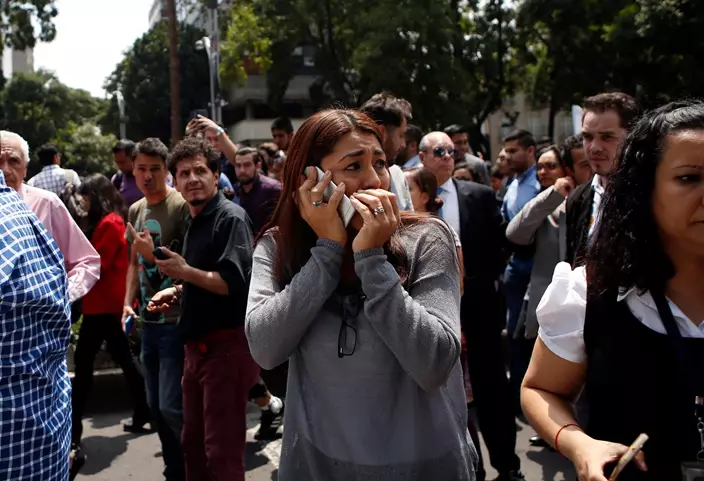
A woman speaks on her cell phone as people evacuated from office building gather in Reforma Avenue after an earthquake in Mexico City, Tuesday Sept. 19, 2017. A powerful earthquake jolted central Mexico on Tuesday, causing buildings to sway sickeningly in the capital on the anniversary of a 1985 quake that did major damage.(AP Photo/Rebecca Blackwell)
His tweet said 64 people died in Morelos state, just south of Mexico City, though local officials reported only 54. In addition, 36 were killed in the capital, 29 in Puebla state, nine in the State of Mexico and one in Guerrero state, he said.
The count did not include one death that officials in the southern state of Oaxaca reported earlier as quake-related.
The federal government declared a state of disaster in Mexico City, freeing up emergency funds. President Enrique Pena Nieto said he had ordered all hospitals to open their doors to the injured.
Mancera, the Mexico City mayor, said 50 to 60 people were rescued alive by citizens and emergency workers in the capital. Authorities said at least 70 people in the capital had been hospitalized for injuries.
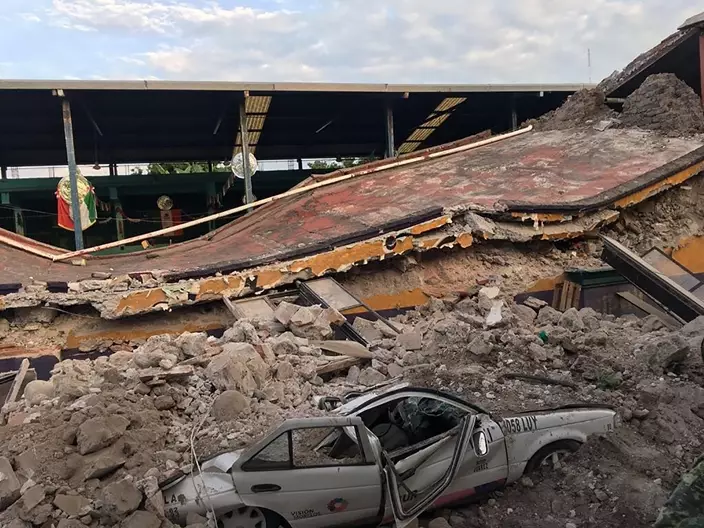
A car sits crushed, engulfed in a pile of rubble from a building felled by a 7.1 earthquake, in Jojutla, Morelos state, Mexico, Tuesday, Sept. 19, 2017. (AP Photo/Carlos Rodriguez)
The federal interior minister, Miguel Angel Osorio Chong, said authorities had reports of people possibly still being trapped in collapsed buildings. He said search efforts were slow because of the fragility of rubble.
"It has to be done very carefully," he said. And "time is against us."
At one site, reporters saw onlookers cheer as a woman was pulled from the rubble. Rescuers immediately called for silence so they could listen for others who might be trapped.
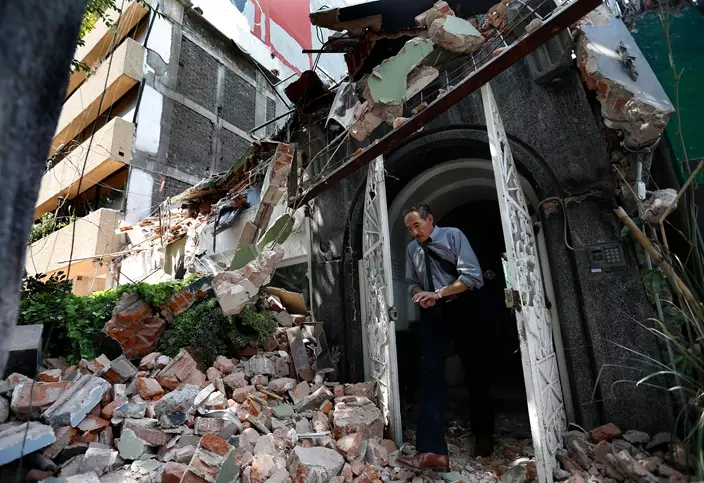
A man walks out of the door frame of a building that collapsed after an earthquake, in the Condesa neighborhood of Mexico City, Tuesday, Sept. 19, 2017. (AP Photo/Marco Ugarte)
Mariana Morales, a 26-year-old nutritionist, was one of many who spontaneously participated in rescue efforts.
She wore a paper face mask and her hands were still dusty from having joined a rescue brigade to clear rubble from a building that fell in a cloud of dust before her eyes, about 15 minutes after the quake.
Morales said she was in a taxi when the quake struck, and she got out and sat on a sidewalk to try to recover from the scare. Then, just a few yards away, the three-story building fell.
A dust-covered Carlos Mendoza, 30, said that he and other volunteers had been able to pull two people alive from the ruins of a collapsed apartment building after three hours of effort.
"We saw this and came to help," he said. "It's ugly, very ugly."
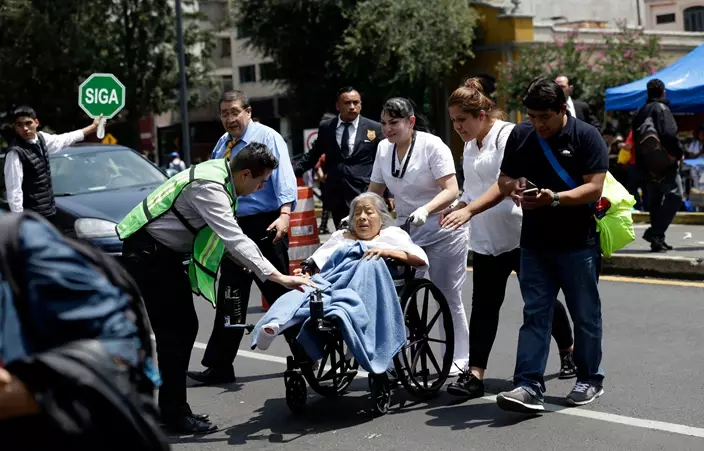
A woman in a wheelchair is evacuated from a clinic as people gather along Paseo de la Reforma Avenue after an earthquake in Mexico City, Tuesday Sept. 19, 2017. (AP Photo/Marco Ugarte)
Alma Gonzalez was in her fourth floor apartment in the Roma neighborhood when the quake pancaked the ground floor of her building, leaving her no way out — until neighbors set up a ladder on their roof and helped her slide out a side window.
Gala Dluzhynska was taking a class with 11 other women on the second floor of a building on trendy Alvaro Obregon street when the quake struck and window and ceiling panels fell as the building began to tear apart.
She said she fell in the stairs and people began to walk over her, before someone finally pulled her up.
"There were no stairs anymore. There were rocks," she said.
They reached the bottom only to find it barred. A security guard finally came and unlocked it.
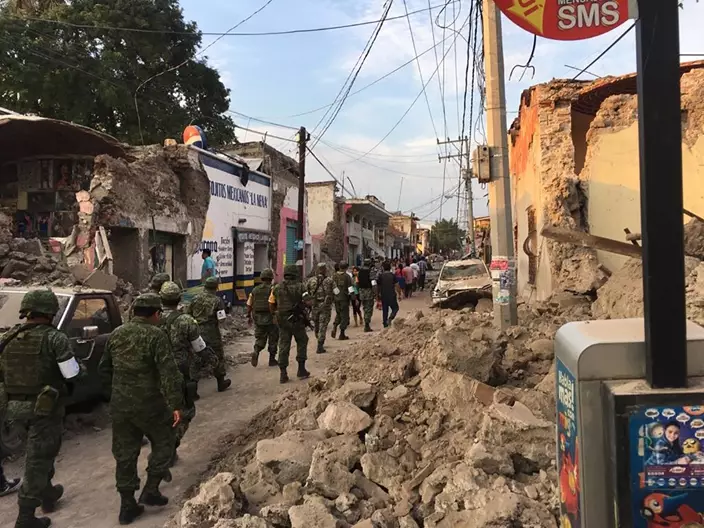
Soldiers walk past piles of rubble from buildings felled by a 7.1 earthquake, in Jojutla, Morelos state, Mexico, Tuesday, Sept. 19, 2017. (AP Photo/Carlos Rodriguez)
The quake sent people throughout the city fleeing from homes and offices, and many people remained in the streets for hours, fearful of returning to the structures.
Alarms blared and traffic stopped around the Angel of Independence monument on the iconic Reforma Avenue.
Electricity and cellphone service was interrupted in many areas and traffic was snarled as signal lights went dark.
The U.S. Geological Survey said the magnitude 7.1 quake hit at 1:14 p.m. (2:15 p.m. EDT) and was centered near the Puebla state town of Raboso, about 76 miles (123 kilometers) southeast of Mexico City.
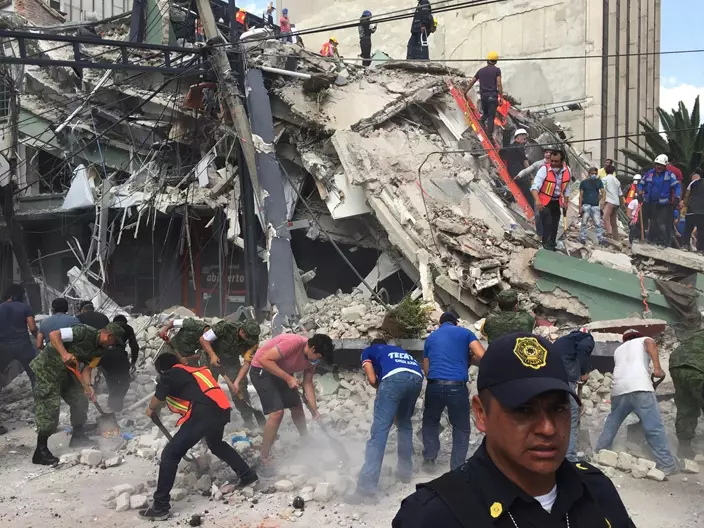
People search for survivors in a collapsed building in the Roma neighborhood of Mexico City, Tuesday, Sept. 19, 2017. (AP Photo/Enric Marti)
Puebla Gov. Tony Gali tweeted there were damaged buildings in the city of Cholula, including collapsed church steeples.
Earlier in the day, workplaces across Mexico City held earthquake readiness drills on the anniversary of the 1985 quake, a magnitude 8.0 shake that killed thousands of people and devastated large parts of the capital.
In that tragedy, too, ordinary citizens played a crucial role in rescue efforts that overwhelmed officials.
Market stall vendor Edith Lopez, 25, said she was in a taxi a few blocks away when the quake struck Tuesday. She said she saw glass bursting out of the windows of some buildings. She was anxiously trying to locate her children, whom she had left in the care of her disabled mother.
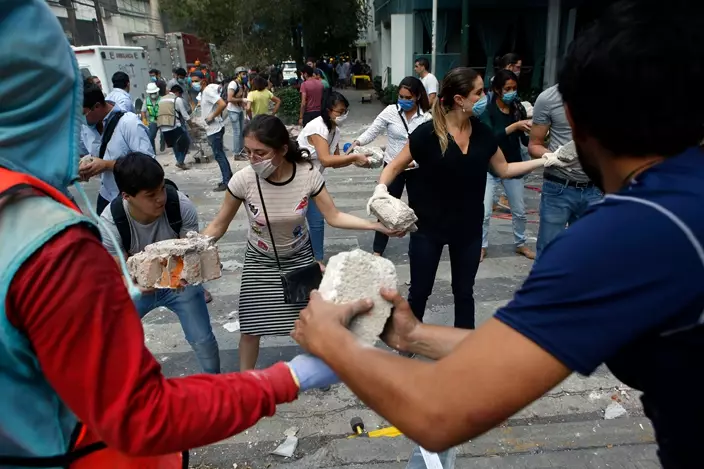
Volunteers pick up the rubble from a building that collapsed during an earthquake in the Condesa neighborhood of Mexico City, Tuesday, Sept. 19, 2017. (AP Photo/Rebecca Blackwell)
Local media broadcast video of whitecap waves churning the city's normally placid canals of Xochimilco as boats bobbed up and down.
Mexico City's international airport suspended operations and was checking facilities for damage.
Much of Mexico City is built on former lakebed, and the soil can amplify the effects of earthquakes centered hundreds of miles away.
The new quake appeared to be unrelated to the magnitude 8.1 temblor that hit Sept. 7 off Mexico's southern coast and also was felt strongly in the capital.
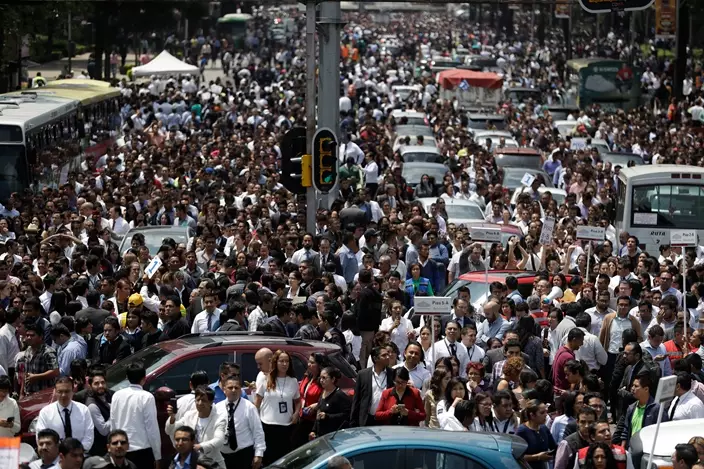
People evacuated from office buildings gather in Reforma Avenue after an earthquake in Mexico City, Tuesday Sept. 19, 2017. A powerful earthquake jolted central Mexico on Tuesday, causing buildings to sway sickeningly in the capital on the anniversary of a 1985 quake that did major damage.(AP Photo/Rebecca Blackwell)
U.S. Geological Survey seismologist Paul Earle noted the epicenters of the two quakes were 400 miles (650 kilometers) apart and said most aftershocks are within (60 miles) 100 kilometers.
There have been 19 earthquakes of magnitude 6.5 or larger within 150 miles (250 kilometers) of Tuesday's quake over the past century, Earle said.
Earth usually has about 15 to 20 earthquakes this size or larger each year, Earle said.
Initial calculations showed that more than 30 million people would have felt moderate shaking from Tuesday's quake.
MEXICO CITY (AP) — Mexico’s president is in a rush to finish the big legislative and building projects he promised before his term ends in September, and experts say officials are getting a bit sloppy amid all the haste.
This week, legislators from the governing Morena party mistakenly submitted the wrong bill on pension reform for a vote in Congress, before sheepishly admitting the error and rescheduling the vote. They claimed Thursday that aides had mistaken one set of papers for another, but the bill almost got approved before the opposition noticed the error.
“In the legislative process, as in life and all activities, human mistakes are made that aren't premeditated, that aren't ill-intentioned,” said Sen. Ignacio Mier, the point man for President Andrés Manuel López Obrador's party in the Senate.
The rushed atmosphere extends to infrastructure, with the president's beloved train projects suffering glaring construction errors in recent months. Cranes have crashed off bridges and pilings have been sunk into supposedly protected cave systems. With the June 2 presidential election approaching, the president wants to finish his administration's projects, fast.
“There is this rush, because López Obrador wants to put as much in place as possible to assure his own policies, so that ... whoever wins (the election), they won't be able to backtrack on it, at least not easily,” political analyst José Antonio Crespo said.
But the pension reform especially has become a lightning rod for criticism, because it would essentially seize unclaimed pension funds if a worker doesn’t start drawing them by age 70.
López Obrador says the seized funds — which he wants to put into a pot for employees whose pensions are too small — would always be available for return if a worker or his dependents show up later to claim them.
“Even if time has passed, they can file a request for the funds to be returned to them,” López Obrador said Thursday.
But the bill mistakenly submitted for a vote late Wednesday actually would have removed some of those protections. For example, employees who didn't draw their pensions by age 70 or 75 because they were still working could still have had their pensions seized.
And because pension withdrawals are already so bureaucratic and restrictive — dependents in Mexico often have to go to court to access a deceased worker's pension fund — the idea that a simple request will get the money returned has been met with derision.
“We are against this, because they are going to loot everybody's account,” said opposition Sen. Rubén Moreira, a member of the old ruling PRI party. “First, because the money in the individual accounts is the personal property of many people, and secondly, because this won't solve the pension problem.”
The tension involves López Obrador's disdain for private or individual benefit programs. The president frequently rails against “individualism” and “aspirationalism,” a term in Spanish roughly equivalent to “getting ahead” or “pulling yourself up by your own bootstraps.” He prefers large, government-run programs.
Mexico's woefully underfunded pension programs were converted in 1997 into individual accounts somewhat akin to the U.S. 401K program, in which a worker and his employer both contribute to a personal retirement investment account.
López Obrador has long criticized that change, saying the government itself should guarantee everyone a pension equivalent to 100% of their last paycheck. Of course, the Mexican government doesn't have enough money to do that, hence the proposed raid on the "unclaimed" individual accounts.
“Taking these individual, unclaimed accounts ... could affect the rights of workers and their beneficiaries, if they don't move to make a claim,” said Orlando Corona, the social security specialist for the Mexican Institute of Financial Executives.
Corona said a big outreach and ad campaign would be needed to remind workers about the importance of claiming their money — something the president's plan doesn't contemplate.
López Obrador has a history of rushing laws through congress without much time for legislators to actually read the bills, just as he has sought to ram through his infrastructure building projects by exempting them from normal permitting and environmental review processes.
On Wednesday, his party pushed through the Senate a law that would prohibit judges from blocking government projects, even if citizens file appeals against them.
Chief among the projects dear to Lopez Obrador's heart are railway lines. Mexico largely abandoned state-run passenger train service in the 1990s, and the president is building rail lines to bring that back. The problem is those projects are either environmentally questionable or too big to finish during his term.
López Obrador has vowed to finish them before he leaves office Sept. 30, bragging they are being built in “record time.” He spends most of his weekends flying around to different construction sites to personally oversee the work.
But apparently it is hard to do careful work in a hurry, both in legislation and in construction. “It is not advisable, but that's the way they're doing it,” said Crespo.
On Tuesday, an 800-ton gantry crane — a huge piece of machinery used to position pre-fabricated concrete bridge spans — came crashing to the ground at an elevated commuter rail line meant to link Mexico City with neighboring Toluca. Nobody was injured, but the accident delayed construction and terrified neighbors.
In January, another crane dropped a huge pre-fab concrete span onto the roadway below, narrowly missing two men who were repairing a truck.
In March, a loose railway fitting caused a train car to derail on the president’s pet project — a tourist rail route known as the Maya Train that is planned for carrying both visitors and local residents on a loop around the Yucatan peninsula.
No one was hurt in the incident, but given that it's meant to eventually be a high-speed train, the oversight was worrisome.
The rail switch involved in the accident is designed to be operated automatically. Though the automated system is not yet in place, the president wanted that part of the line up and running anyway.
So the switch — which shunts train cars onto another track — has to be manually loosened, moved and returned to its original position by hand. Someone apparently didn’t tighten the fitting down again.
On the same project, the government has acknowledged that steel and cement pilings meant to support an elevated section of the tracks were driven directly through the roofs of sensitive limestone caves.
The network of caves, sinkhole lakes and underground rivers along Mexico’s Caribbean coast are both environmentally sensitive and have been found to hold some of the oldest human remains in North America.
Follow AP’s coverage of Latin America and the Caribbean at https://apnews.com/hub/latin-america
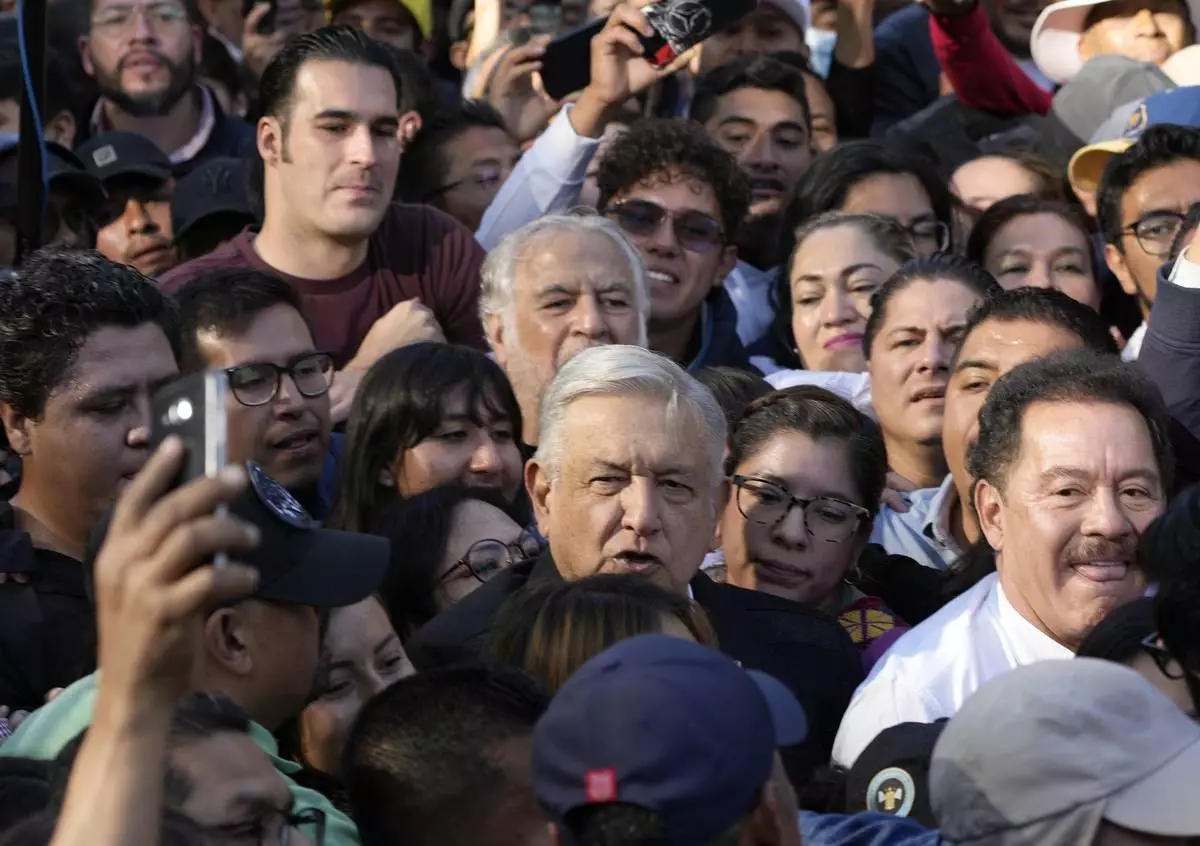
FILE - Mexico's President Andrés Manuel Lopez Obrador, center, and Mexican Sen. Ignacio Mier, far right, walk with supporters during a pro-government march, in Mexico City, Nov. 27, 2022. Legislators from the governing Morena party mistakenly submitted the wrong bill on pension reform for a vote in Congress in April 2024, before Mier and fellow Morena legislators admitted the error and rescheduled the vote. (AP Photo/Fernando Llano, File)
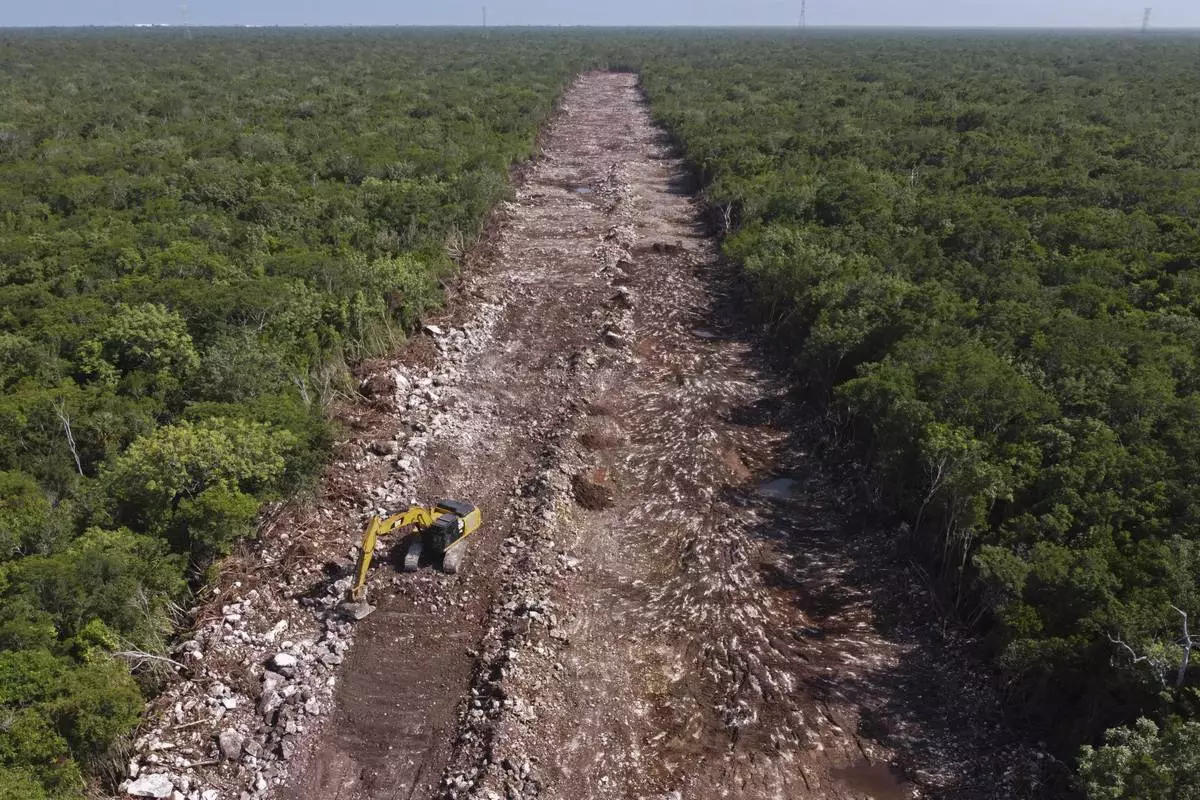
FILE - A bulldozer clears an area of forest that will be the line of the Mayan Train in Puerto Morelos, Quintana Roo state, Mexico, Aug. 2, 2022. Mexico’s President Andrés Manuel López Obrador is in a rush to finish the big legislative and building projects he promised before his term ends in September 2024, chief among the projects are railway lines, like the Mayan Train. (AP Photo/Eduardo Verdugo, File)
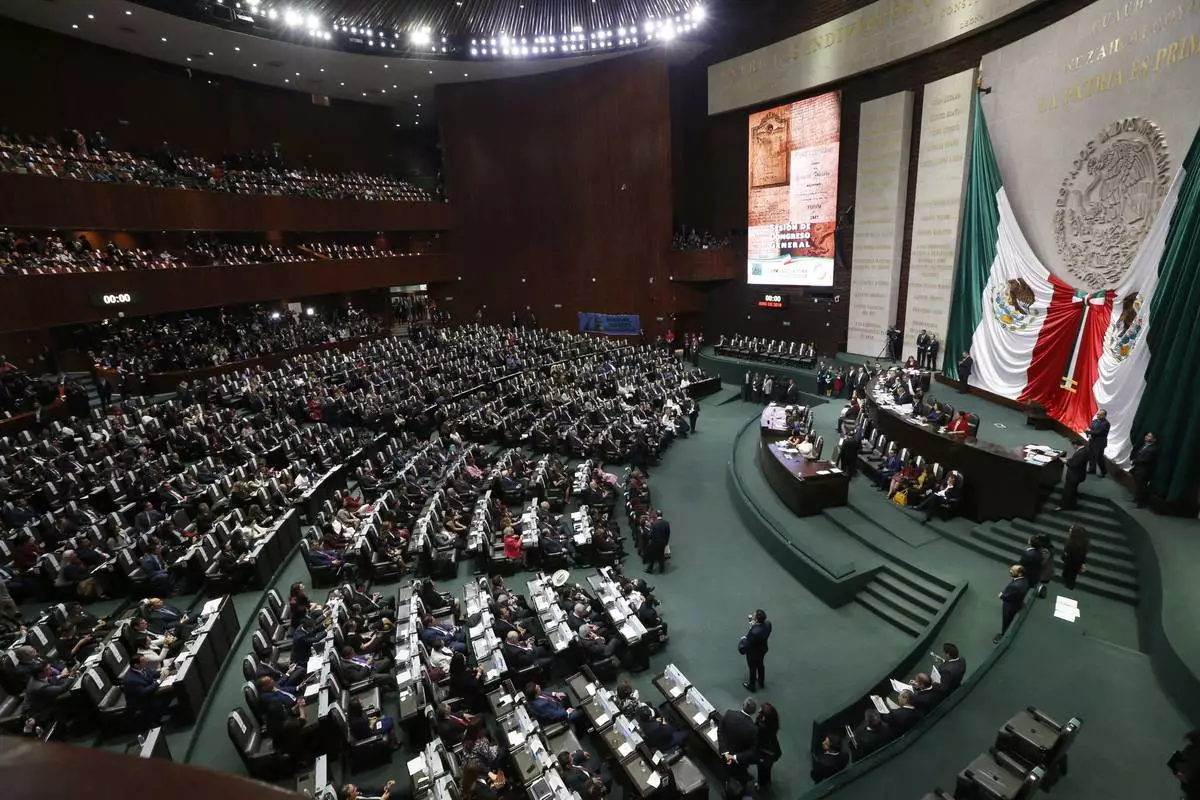
FILE - Legislators fill the lower house of Congress as the wait for the presidential inauguration ceremony of Andres Manuel Lopez Obrador, at the National Congress in Mexico City, Dec 1, 2018. Lopez Obrador is in a rush to finish the big legislative and building projects he promised before his term ends in September 2024, (AP Photo/Marco Ugarte, File)
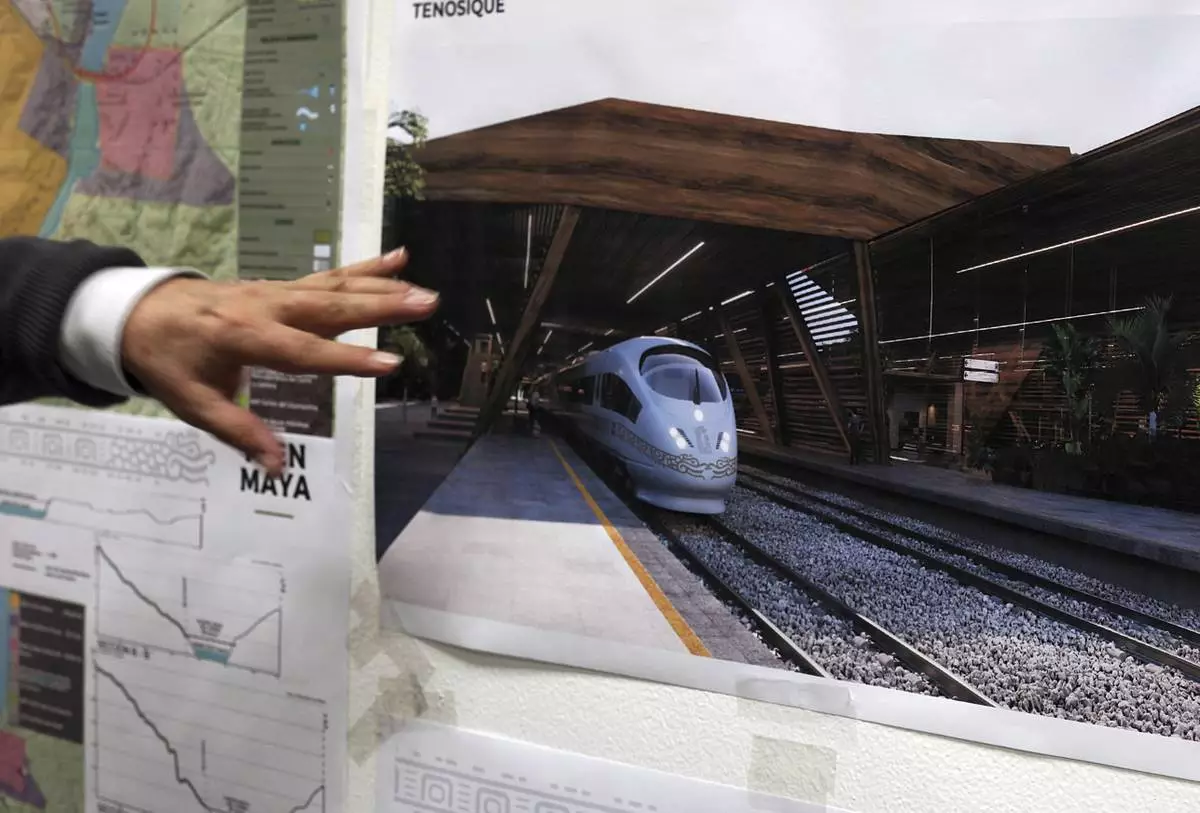
FILE - Rogelio Jiménez Pons, director of Fonatur, points to photos of a planned train through the Yucatan Peninsula, during an interview in Mexico City, March 18, 2019. Mexico’s President Andrés Manuel López Obrador is in a rush to finish the big legislative and building projects he promised before his term ends in September 2024, chief among the projects are railway lines, like the Mayan Train. (AP Photo/Marco Ugarte, File)

















